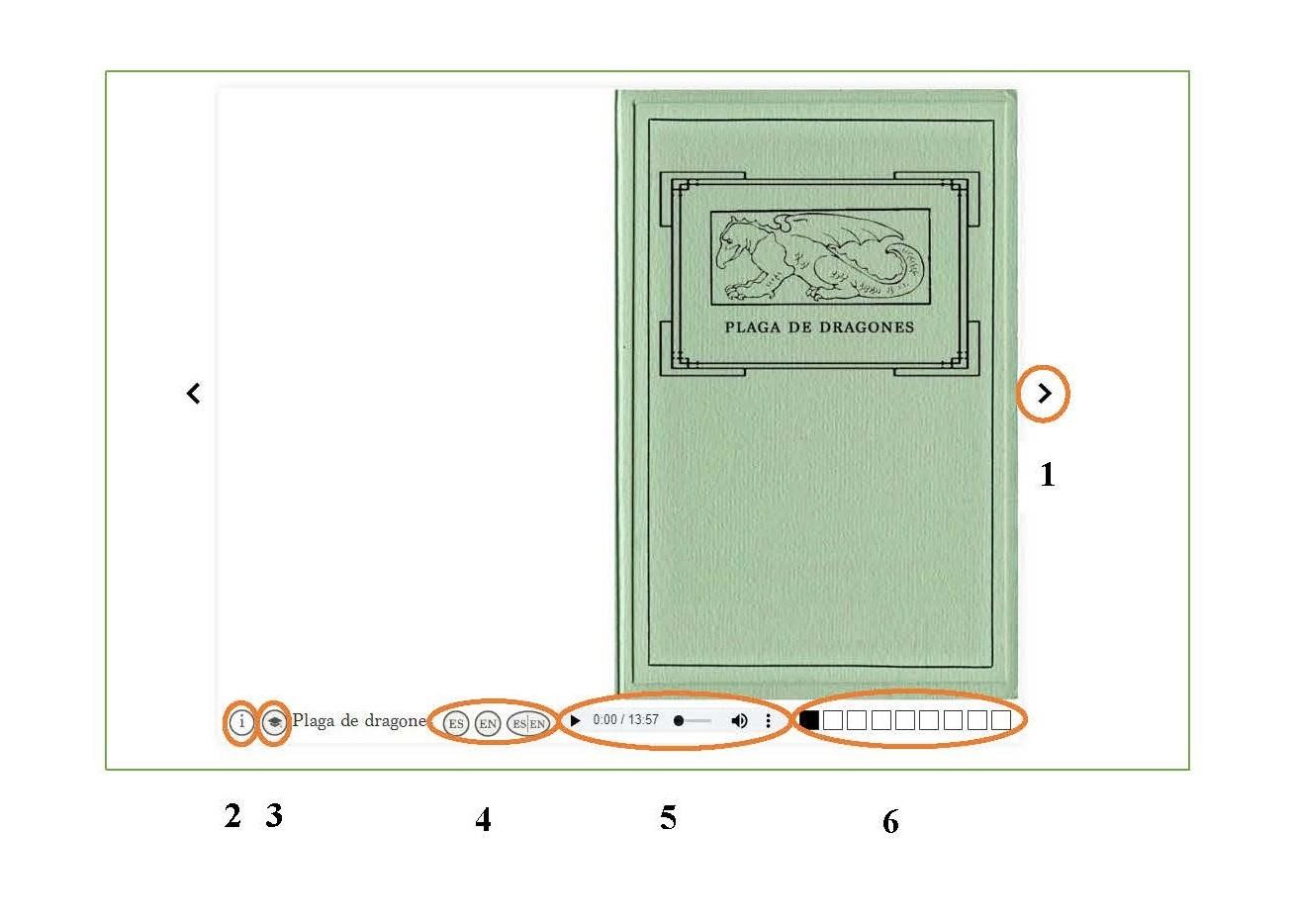Didactic guide
INTRODUCTION:
This short didactic guide is aimed at supporting teachers in the use of the tool. It includes the following sections: the objectives of this digital edition of Plague of Dragons, the intended audience, and the description of the interface and the type of annotations included. We also provide some suggestions for the exploitation of this resource in the classroom.
download PDFThis new digitalized and enriched version of the Plague of Dragons tales is intended to encourage the pleasure of reading in the new generations through a collection of stories that, despite the chronological distance, maintain their original interest. To this end, three versions of the stories have been created, with their corresponding oral narration, teaching table and annotations:
- Spanish (ES): Original version of the story in Spanish.
- English (EN): English translated version.
- Bilingual version (ES / EN): Version with one language on each page (face-to-face), with contrastive annotations in the stories “Plaga de dragones/A plague of dragons”, “Una ciudad de libros/A city of books”, “Veraneo estropeado/Spoilt summer holidays” and “En estado de sitio/Under siege.”
The Spanish version is aimed at developing the reader's skills, especially in the field of literature and creative writing. The activities proposed in the annotations are aimed at enriching the reading experience, bringing the culture of the time in which these stories were published to current generations, thus contributing to the establishment of connections between different people, times and places. Practical and closed examples explain concepts in the field of literary studies (such as gender, intertextuality, types of narrators, etc.), complemented transversally with exercises and information pertaining to other areas of knowledge, such as Biology or the Social Sciences. Similarly, different activities are proposed to encourage the reader to improve his reading comprehension, continue with other stories, or write his own.
The English version is aimed at assisting the student in learning the English language in a playful and integrative way in relation to the development of other skills. It can be used in the classroom and hence constitute a teaching resource as well.
The main objective of the bilingual version is to recover the mother tongue in the language classroom and use it as a learning resource for the second language, English, from a contrastive perspective, for Spanish-speaking students. From this bilingual version of the story, contrastive activities between both languages can be proposed in order to make the student reflect on linguistic and intercultural aspects of interest. The annotations for this contrastive bilingual version are implemented in four stories (1, 3, 5 and 12).
The icons in the margins of the story give access to different types of annotations and activities that seek to encourage young readers to develop skills that more than one hundred Spanish teachers have previously identified as necessary in their training process and that, in addition, coincide with what several reports of the European Commission establish as priority competences that young people must have today to successfully access the labor market. These skills and competencies have been synthesized in large groups of annotations, identified by a different icon (as we will see in Table I).
This edition is intended for readers who are more or less native Spanish speakers and who have a level of English corresponding to a B1 in the CEFR. This tool has been developed primarily for them, although it is also possible to use it as a tool for teaching Spanish to foreigners at an advanced level. Specifically, it is intended for children between 9 and 13 years old, although teenagers and adults can also enjoy reading these stories. It is also a suitable material for use in the classrooms of the second (3rd and 4th) and third cycle (5th and 6th) of primary education, in its Spanish version, and given the level of English required they can also be useful in 1st and 2nd of secondary education. The annotations are aimed at the reader, so the tool can also be used autonomously, outside of a formal school context.

1. Arrow to turn the page
2. Key of annotation icons
3. Didactic guide for each story
4. Icons to access the different versions:
5. Audio: The complete audio of each story is in the lower tab (available for download), also having the audio per page embedded in each page of the story.
6. Signaling of reading progression: Each black square is equivalent to a screen or double page.
| Skill | Icon | Skill | Icon |
|---|---|---|---|
| Reading comprehension and context
Explanation of contextual, historical or cultural information, difficult for the current reader. |
 |
Collaborative and emotional work
Proposals for activities to develop group work and emotional intelligence. |
 |
| Oral comprehension
Annotations aimed at developing auditory reception, using the oral dimension of language, sounds and music. |
 |
Creativity
Proposals to work imagination, fantasy and sensitivity from reading. |
 |
| Critical capacity and intertextuality
Annotations that promote critical thinking and deeper knowledge of literary strategies. |
 |
Interactive elements
Interactive elements
(Puzzles, image galleries, exercises, etc.)
|
 |
| Communication
Exercises for oral communication (for the English version). |
 |
Culture and society
Activities to learn sociocultural and pragmatic aspects characteristic of each language (specific icon for the bilingual version). |
 |
| Vocabulary:
Activity for the acquisition of new lexicon that appears in the text (specific icon for the bilingual version). |
 |
Grammar:
Activity to work morphological and syntactic aspects that appear in the text (specific icon for the bilingual version). |
 |
Table I: Icons to identify the different types of annotations and the skills they seek to develop.
Both the Spanish version and the English version are accompanied by two types of notes: vocabulary notes (indicated by a faint dotted line under the word) and specific annotations aimed at practicing different skills (marked with different icons, see table I). Some notes could have been represented using several icons, however, in order to keep a clean design of the page, we have chosen to leave a single icon, favoring those that are not of reading comprehension and context, which are the most common. The lower menu of the tool has some annotations that are always available during reading.
 |
Key with the types of icons used in each version (Spanish, English, and bilingual). |
 |
Didactic table for each story, with a brief summary of it, guidelines for the didactic exploitation of the story, including the vocabulary and the type of activities proposed in the annotations. |
 |
This icon is used to listen to the embedded audio on each page. |
- We propose the presentation in class of the following excellent educational video about Saturnino Calleja before starting to work with the story to contextualize it:
- Carrying out activities in which the story is introduced, relating it to the world of references of current children.
- Listen together as an audiobook, without reading the text, pausing from time to time and consulting students if they need more information, accessing the enriched areas and discussing them.
- Reading the book with the audio, individually, guided by the reading speed and reading mode of the audio.
- Reading the book without the audio, with freedom to consult the enriched areas, according to individual rhythm.
- Work in pairs: one listens to the audiobook and then has to narrate it to his partner. Then the children who have been told the story can share it with each other to fill in possible gaps or clear up doubts.
- Listen to the audiobook and recreate the story in groups: with images provided by the teacher that they have to order, with drawings of the students, with schematic maps, etc.
- Provide each student with a fragment of the text to be read individually. Listen to the audiobook and the students have to be ordered physically, depending on the order of their fragments.
- Joint listening to the audiobook and predicting events that may happen later: the teacher stops the audio and the students raise their ideas.
- Expert groups: assign to each group of students a type of extension resource (context, creativity, collaborative work, etc.) and make a reading of the book reviewing only the type of resource that corresponds to them. Then heterogeneous groups are created in which there is at least one student of each type of resource and they explain to each other what they have discovered.
- Character development and presentation:
- Individual mode: Each student recreates the chosen character from the story, extending a description of his character or drawing it.
- Group mode: In small groups they perform a theatrical fragment of the story or variations thereof.
- Create new student annotations for other aspects or passages of the story that have generated interest or curiosity, and that were not already enriched. Information search and exhibition.
- Generate with the students an audiobook of another work, from this model. For example, undertake an analysis of the use of voice in the audio of the story, establishing the elements that improve the listener's understanding, and then create an audiobook themselves taking into account these quality requirements.